








Budget
£84.99
Ideal for larger gardens or allotments, this traditionally styled composter is really sturdy, made from interlocking, pressure treated, FSC certified timber panels. Quick and easy to assemble, no tools required, the timber panels simply slot together to create a secure structure.


per 3 £7.99
Made from 100% biodegradable vegetable fibres, these natural jute sacks are perfect for making leaf mould. Simply fill with leaves and they will naturally rot down into leaf mould. Size16"widex2’3”high,

£6.99
Speed up the composting process in traditional compost heaps with this biological compost accelerator
Beehive Compost Bin £149.99

This attractive bin is compact yet efficient at turning kitchen and garden waste into a useful, nutrient rich compost.

9 Durable construction using FSC certified, pressure treated timber
9 Efficient composting with aeration slots helping to speed up composting
9 Easy filling the full size lid can be propped open
9 Easy to empty with a removable base panel for extracting finished compost.
2’5”widex2’5”deepx2’11”high,211ltrcapacity.
Compost Thermometer £12.99


A mix of specially selected microbes and enzymes this chemical free powder can be used wet or dry. Each pack contains five 10g sachets. Each sachet can treat up to 600 litres of waste.
£89.99 without stand
£104.99 with stand
With a 20” square shape and 48” height this compact water butt fits into small spaces yet holds 250 ltr of water.
Available with or without a stand that lifts the water butt 12” off the ground, making it easy to fill a watering can from the tap.
If you want to dunk your watering can into the butt simply remove the secure lid and replace after filling. A diverter is included so you can connect the water butt to a 68mm round or 65mm square plastic household downpipe.
Rainwater Harvesting
Kit £13.99
Designed to fit most makes of greenhouse with square gutters (3.5cm wide) it lets you divert water from your greenhouse gutter into a water butt. Made from hardwearing plastic, it includes a downpipe, end cap and fittings. Slots into the gutter end, order one kit per gutter

Darlac Low Pressure Water Timer £33.99
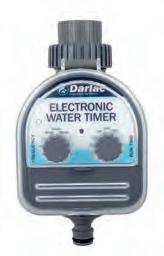
For controlling irrigation systems run from mains water or a water butt. Simply set how long and how often you want to water and the timer does the rest.
How Long - from 1 min. to 2 hrs a day
How Often - from 1 to 24 times a day.
An essential factor to creating a good, rich garden compost is to monitor the temperature. This simple to use, bi-metal dial thermometer measures compost temperature over the range of 0-100°C. Size19½”long stainlesssteelstem and2”diameterdial.
It incorporates an easy to read dial that indicates 3 colour-coded zones; warm, active and hot.
Citrox Disinfectant

per 500ml £8.55
Effective against a wide range of bacterial and fungal organisms. This powerful disinfectant is based on extracts of citrus fruit. Use to keep water butts ‘sweet’ and irrigation water clean and free from disease. 500mlsdilutesto10litres
FreshaTank Antimicrobial Disc

£15.99
Keep your water butt fresh and odour free with this everlasting
Made from copper and silver, it uses the natural biocidal effects of real silver to destroy germs including viruses, bacteria, fungus and water-borne diseases.
Onedisctreats90ltrofwater.
Editor: Steve Ott, sott@mortons.co.uk






Deputy editor: Emma Rawlings, erawlings@mortons.co.uk

Staff writer: Tony Flanagan, tflanagan@ mortons.co.uk
Advertising: Craig Amess, camess@mortons.co.uk Tel. 01507 529529



Gardening has to be one of the best ways to help the planet. In our own back yards on this vast world on which we live we can do our bit to help our little patch of soil be the healthiest it can be. In turn this can grow wonderful plants which can help our local wildlife. We can grow our own organic fruit and vegetables, helping reduce waste and food miles and producing healthy food for ourselves and our families. Gardening is our saviour in so many ways and on the pages of this publication we offer some tips to help. Within these pages you will find out how to grow bumper crops using nature’s own army of gardening friends – from pest predators to friendly bacteria in the compost heap and networks of crop-boosting fungi in the soil. There are sections on composting, companion planting, green manures, mulching, seed saving, soil health and encouraging wildlife. Plus great ways to save money and help the planet by recycling and repurposing things that might otherwise have ended up in landfill. An essential read for those wanting to garden in a greener, more sustainable way. And after you have read it, you could always compost it!
Emma Rawlings Deputy Editor, Kitchen Garden magazine www.kitchengarden.co.ukDesign: Burda Druck India Pvt. Ltd.

Publisher: Steve O’Hara
Published by: Mortons Media Group Ltd. Media Centre, Morton Way, Horncastle, Lincolnshire LN9 6JR
Printed by: William Gibbons and Sons, Wolverhampton
BARCODE: 5059464134009-05
















© 2022 Mortons Media Group Ltd. All rights reserved. No part of this publication may be reproduced or transmitted in any form or by any means, electronic or mechanical, including photocopying, recording, or any information retrieval system without prior permission in writing from the publisher



“The glory of gardening: hands in the dirt, head in the sun, heart with nature”
(Alfred Austin)
32
14

GREEN GARDENING
7 Caring for your soil

Knowing your soil type and how to keep it healthy
10 Ditch the spade!
Not digging over your soil can improve the condition of your soil and improve your crop yields
14 Good companions
Growing particular plants among your crops can be beneficial



16 Good enough to eat
Our pick of popular edible flowers available to decorate and flavour food

20 How to make comfrey feed
Grow comfrey to harvest and turn into fertiliser for your other plants
23 Get set, sprout!
How to grow sprouting shoots which are delicious and nutritious
28 Save your seeds
Save money by saving some seed from your crops
32 Go green with manures
Grow a crop of green manure to dig back into your soil to improve it

36 Composting made easy
Here are some tips on creating nature’s best soil conditioner

39 Mulches and soil conditioners
Give your soil a boost by protecting the surface and incorporating organic matter
WELCOMING WILDLIFE
43 Boost your biodiversity

Encourage wildlife to your plot to improve your crop yields

49 Attracting birds to your garden
Birds play an important part in a balanced ecosystem so it is good to encourage them onto your plot
42
52 Make room for blooms
Grow some flowers on your veg plot and reap the rewards

56 Protecting our native pollinators
We would not harvest the crops we do without the work of pollinators so encouraging them is beneficial
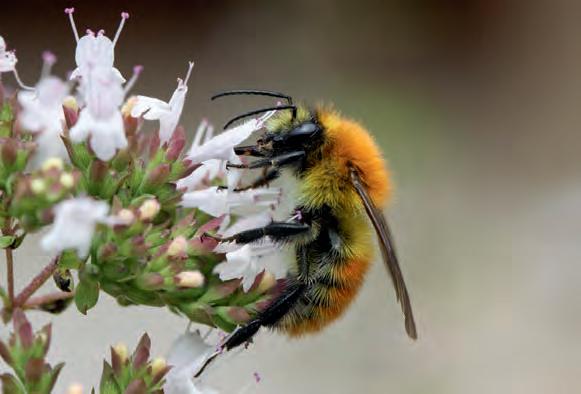
61 Go wild on the plot
What insects are good for your veg plot and how to encourage them
66 Make a winter home for wildlife
Some top tips on providing shelter for wildlife during the winter months

71 Something for nothing


Recycle everyday objects into useful garden equipment

76 Quench without the drench
Water needs conserving so here are some top tips to save it

80 Top 10 ways to reduce plastic
How to reduce your reliance on plastic in the garden
82 Seven steps to a low carbon garden


Tips on making your kitchen garden more planet-friendly

MONEY-SAVERS
18 Save on a subscription to Kitchen Garden magazine




Save pounds and receive free seeds every month with a subscription to the best-selling magazine for those who want to grow their own
64 Great reader offers



Make your gardening pound go further with our super money-saving reader offers


Ga rdening wi th the en vi ronm ent in mind can m ean adopting many different techniques including caring for your soil, c omposting and growing your own plant feeds

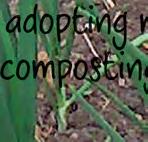



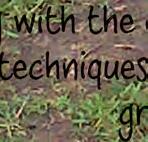


Good soil is essential if you want to produce healthy crops so this is the starting point for growing great fruit and veg. Here are some tips to keep your soil hale and hearty

It helps to know what type of soil you have. A basic gardening text will help you tell whether your soil is predominately sand, silt or clay (try searching www.rhs.org.uk for ‘soil types’), but also feel and listen to it when you are out on the plot. A sandy soil is gritty and falls through your fingers – you rarely hear it squelch. Clay is so sticky when wet that you can make models out of it. Silts are squeaky and slippery. You are stuck with your soil type – you can’t change it. However, you can change the soil structure.


In a well-structured soil, the basic particles of sand, silt and clay have formed larger fragments so it is crumbly – imagine breadcrumbs or making a topping to an apple crumble. The spaces between the crumbs allow air and moisture into the soil, and allow excess water to drain away, so plant roots and all the creatures that live there can breathe. When clods of a well-structured soil dry out on the surface, you can break them up easily with a fork.

The acidity or alkalinity of a soil is basically the amount of chalk or lime it contains. This matters because it influences how easily plants can take up nutrients, and how comfortable it is for earthworms and other soil organisms to live there. The acidity or ‘pH’ depends on the soil type and area of country where you live but also on very local factors – your neighbour might be growing beautiful azaleas (a sign of an acid soil), but if your garden is on the site of an old building with lime mortar, yours could be very alkaline. A slightly acid soil (pH around 6.5) is best for veg growing.






If you are taking on a new plot, it is worth doing a pH test – use a DIY kit from a garden centre or, even better, send a soil sample away to a laboratory.
If a pH test shows that your soil is very acid, add ground limestone (garden lime) to the plot in winter as the results recommend. However, don’t automatically add lime every year. Although most soils will tend to turn more acidic over time, some materials which you already add have a liming affect – wood ash, municipal green waste compost, mushroom compost and comfrey liquid, for example.

Keeping the soil covered with growing plants is one of the best ways to build its structure. Pictured is grazing rye, an overwintering green manure crop

Turn over a clod of soil and you’ll probably spot several earthworms and perhaps a centipede scurrying away. If a robin comes to join you, his beady eyes will spot a few smaller creatures too. However, most life in the soil is microscopic, made up of bacteria, fungi, nematodes, mycorrhiza and other organisms with even stranger names. You can’t see them, but you can see the results of their work. They decompose organic matter, making nutrients available to plants. They help soil particles stick together, improving the soil structure. They form beneficial relationships with plant roots, effectively extending their reach so they have greater access to nutrients and water. Of course, there are also harmful soil microorganisms – some of them, such as white rot on onions, all too familiar – but in a healthy soil, the ‘goodies’ attack the ‘baddies’ or simply outcompete them for moisture and nutrients.
Earthworms have their own important roles. Those found near the surface (the smallest) help break down leaf debris. Those which live just below mix and aerate the soil and produce casts rich in nutrients. The largest deep-living earthworms make permanent vertical tunnels into which they pull debris, and these help to aerate and drain the soil. Regularly counting the number of earthworms in a spadeful of soil is a good way to monitor your soil’s health.
 Check the acidity of the soil (its pH), particularly if you are starting a new plot
Seeing a lot of earthworms when you dig the soil is a good sign the soil is healthy
Check the acidity of the soil (its pH), particularly if you are starting a new plot
Seeing a lot of earthworms when you dig the soil is a good sign the soil is healthy


Living roots are best at building up the soil structure and feeding the community of soil creatures and keeping the soil full of plants at all times makes it feel wanted. Intercrop widely spaced plants with other quick-growing ones. Sow green manures in bare beds – annuals such as phacelia or mustard or overwintering grazing r ye can be sown in early autumn when summer crops are over. Think twice before clearing crops and annual weeds just for tidiness – if they are not harbouring pests or diseases or shedding seeds, let them grow until you need the space.
Wait until spring to add manure or compost to prevent nutrients leaching out

Avoid compacting the soil, especially in wet conditions. Its light breadcrumb structure can instantly turn to heavy pancake, and you can almost feel it getting out of breathe. Even light pressure can cause a hard layer or ‘cap’ to form on the surface preventing seedlings emerging. Permanent beds which you can work just from the paths mean you never have to tread on the soil – they don’t necessarily have to be raised up or have posh edging.


Compost and manure are food for the soil – for the soil-dwelling creatures and the plants – and they help improve the soil’s structure. However, don’t add them until spring otherwise the nutrients they contain will wash out over winter. A layer of leafmould, hay or straw is a better autumn cover for bare beds. You could use a mixture of fallen leaves and grass mowings. Woody plants such as fruit trees and bushes can be permanently mulched with coarser material – hay, bark, straw or shreddings made from small leafy branches.


Digging turns the world of the soil dwelling creatures upside down. It severs all the drainage and aeration channels that the worms have made and the microscopic strands of fungi. Rotavating is worse, shattering the soil structure and creating a ‘pan’ (a compacted layer) at the depth of the blades. Dig new ground initially to break up hard layers and remove any woody roots, large stones and maybe even builders’ rubble! After that avoid cultivating wherever possible. Compost and manure can be spread on the soil surface, which will develop a crumbly ‘tilth’ making it easy to pull out weeds and sow seeds. Turn to page 10 for more information on the no digging approach.




The traditional reason for rotating crops on the veg plot is to avoid the build-up of pests and diseases, but it can also improve the general health of the soil.

Creatingpermanent narrow beds means that you never have to tread on the soil
Digging is synonymous with vegetable growing. It’s the belts-andbraces start to ever ything we do – after all, how else would you incorporate the annual dump of compost but what if we’ve got it all wrong? What if you could achieve stunning results without the back-breaking effort? To many traditionalists it sounds implausible, even lazy. And yet more and more of us are ditching the spade only to discover the incredible results that can be enjoyed without e ver breaking ground again.
Pioneers like no-dig guru Charles Dowding (www.charlesdowding. co.uk) have been blazing a nodig trail for years – and they’ve the evidence to back up their decision. Charles’ own meticulous comparison of dug and no-dig beds demonstrates superior crops and a measurable yield boost to boot, with his no-dig beds producing seven percent more vegetables on average. As time passes the difference only grows starker as the no-dig beds mature and become more complex.






Nature doesn’t do digging. Instead she creates then nourishes soil through the gentle addition of leaf litter and other organic materials. The only ‘digging’ is done by the legion of worms, bugs and microorganisms found within the soil. No-dig gardening adopts this easy-does-it approach, swapping digging for mulching. The spade only comes out of the shed to dig larger planting holes or to perhaps help ease out deep rooters like parsnip.
Leave the soil alone like this and the life it contains remains undisturbed too. This is a big deal. When soil isn’t repeatedly torn apart worms have the time to create air channels, improving soil structure and drainage. Meanwhile intricate networks of mycorrhizal fungi establish, making more of the soil’s nutrients available to plant roots. Both soil and plants become more resilient over time, with fewer or no additional fertilisers required for the same or better results.
Weeds are also greatly reduced because no new weed seeds are brought to the surface. With every passing season weeds become fewer and further between, until weeding becomes a quick and easy whip-around with the hoe to sever the few rogues blown in from elsewhere. Soil-borne pests, especially slugs, take a hit too, as natural predators thrive and a rougher, bumpier soil (at least at slug scale) impedes the progress of our arch-nemeses!

At the end of the growing season it was traditional to ‘dig over ground’ ready for the next. But are we doing more harm than good? Maybe it’s time to adopt a less invasive approach?The National Trust garden at Clumber Park in Nottinghamshire has some nodig beds. Here they heaped up with organic matter and bark chipping pathways between them

Setting up a new no-dig system isn’t difficult, but you need plenty of cardboard and a bulk load of organic matter to start with.
You can make beds straight onto a cut lawn if you wish. On goes a layer of cardboard (brown cardboard, without



Of course, no-dig growing isn’t a sit-back, feet-up solution; you still need to shovel on the organic matter! But it’s an awful lot easier than digging it in. You can also streamline mulching and general crop care still further by getting clever with how growing beds are laid out.


No-diggers rarely walk on their soil, preferring to complete most tasks by reaching into beds from paths set out between them. Creating beds no wider than 1.2m (4ft) enables the gardener to reach the middles from the sides, while paths of at least 45cm (18in) width allow for easy movement between them.

Next cover in organic matter. For the set-up you need lots of it – at least 8cm (3in) of the stuff You can use any wellrotted compost or manure (check it’s free of any herbicide residues). Lay it onto the cardboard/ground, rake it level and walk away.
If you have a variety of organic matter then prioritise the finest material for the top of the bed and the lumpiest materials for the bottom layer. In this way plants have time to establish before sending roots further down to chunkier depths.
Starting new beds off in autumn/ early winter gives the organic material ample time to break down further with the regular frost-thaws of winter.

glossy printing on it), which is heavily overlapped so there were no gaps. This cardboard layer isn’t necessary in every situation but it does offer an insurmountable barrier for most lawn grasses and annual weeds. You can source enough cardboard from local recycling points, or if you don’t fancy ‘dumpster diving’, look on local Facebook groups or websites such as Freecycle. The cardboard will rot down over several months, contributing to the soil you’re gently nurturing.
The secret to a successful no-dig garden is the regular additions of organic matter. These are laid onto the surface as a mulch at least once a year, preferably in the autumn when the ground is bare. Don’t scrimp! Add a 3-5cm (1-2in) layer of welldecomposed crumbly compost, manure or leaf mould.
There are other benefits to a bed system. Organic matter used for mulching suddenly goes a lot further when it’s concentrated onto just the growing areas, while zoning the kitchen garden into manageable beds makes general maintenance less daunting and crop rotation a whole lot easier. It is best to create beds so you do not

1
Begin by clearing any debris and large stones from the site. Dig out larger perennial weeds and their roots – this is the only digging you’ll do!

2 Areas of lawn or annual weeds can be cut back then covered over with a layer of plain cardboard to suppress regrowth. Ensure a generous overlap between the cardboard pieces.
4




Some no-dig gardeners go a step further by adding a top layer of shredded bark or wood chips, which are easily pushed aside for the initial planting.
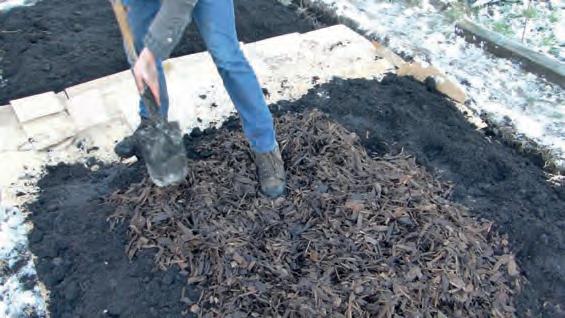

3
Now for the organic matter: wellrotted compost or manure of a fine texture is best. Lay it nice and thick – at least 8cm (3in) deep – then rake level.